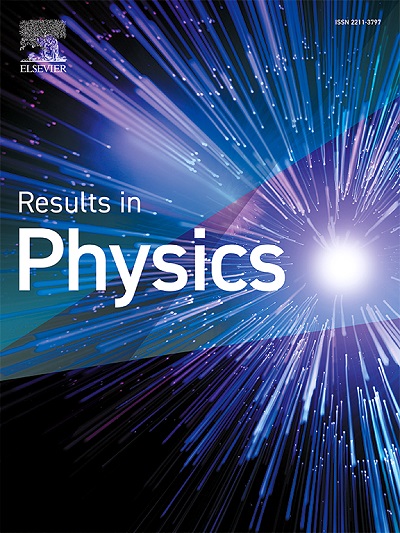Nanoindentation of nickel film by magnetron sputtering ion plating on sapphire: Molecular dynamics simulations and experiments
IF 4.4
2区 物理与天体物理
Q2 MATERIALS SCIENCE, MULTIDISCIPLINARY
引用次数: 0
Abstract
Magnetron sputtering deposition of metals on sapphire (-Al2O3) has emerged as significant research focus in advanced manufacturing due to its critical role in enhancing sapphire’s performance. This study examines the effects of varying negative biases (60 V, 80 V, 100 V) and annealing treatments on the mechanical properties of Ni films deposited on sapphire. Molecular dynamics (MD) simulations and experimental validation based on results of deposition experiments. With increasing negative bias reduces the grain size of the Ni film and decreases the (111)/(100) phase ratio. After annealing, residual stress within film is released, resulting in increased grain size and a higher content of (100) phase. MD simulations reveal that higher negative biases lead to increased dislocation density in Ni film, with plastic deformation predominantly governed by Shockley and Stair-rod dislocations. After annealing, dislocation density decreases, and under 80 V and 100 V conditions, the emergence of Hirth dislocations facilitates earlier onset of plastic deformation. Differences in phase composition within Ni film cause atomic displacements during indentation to exhibit directionality, which diminishes after annealing. Furthermore, the von Mises strain initially decreases and then increases with rising negative bias. Notably, at 80 V, the film achieves an optimal balance of moderate grain size, low dislocation density, and controlled phase composition, minimizing von Mises strain and exhibiting the highest elastic modulus and hardness. The experimental findings align with MD simulation results based on the COMB3 potential, confirming the reliability of the simulations. This study provides theoretical insights into the mechanical behavior of nanocrystalline Ni films under mechanical loading.
蓝宝石表面磁控溅射离子镀镍膜纳米压痕:分子动力学模拟与实验
磁控溅射沉积金属在蓝宝石(α-Al2O3)上的研究已成为先进制造领域的重要研究热点,因为它对提高蓝宝石的性能具有重要作用。本研究考察了不同负偏压(60 V、80 V、100 V)和退火处理对沉积在蓝宝石上的Ni薄膜力学性能的影响。基于沉积实验结果的分子动力学(MD)模拟和实验验证。随着负偏压的增大,Ni膜的晶粒尺寸减小,(111)/(100)相比减小。退火后,薄膜内残余应力释放,晶粒尺寸增大,(100)相含量增加。MD模拟表明,较高的负偏位导致Ni薄膜中的位错密度增加,塑性变形主要由肖克利位错和阶梯位错控制。退火后位错密度减小,在80 V和100 V条件下,Hirth位错的出现有利于塑性变形的提前发生。镍膜内相组成的差异导致压痕过程中的原子位移表现出方向性,退火后原子位移减小。随着负偏压的增大,von Mises应变先减小后增大。值得注意的是,在80 V时,薄膜达到了中等晶粒尺寸、低位错密度和可控相组成的最佳平衡,使von Mises应变最小,并表现出最高的弹性模量和硬度。实验结果与基于COMB3势的MD仿真结果一致,验证了仿真结果的可靠性。本研究为纳米晶Ni薄膜在机械载荷下的力学行为提供了理论见解。
本文章由计算机程序翻译,如有差异,请以英文原文为准。
求助全文
约1分钟内获得全文
求助全文
来源期刊

Results in Physics
MATERIALS SCIENCE, MULTIDISCIPLINARYPHYSIC-PHYSICS, MULTIDISCIPLINARY
CiteScore
8.70
自引率
9.40%
发文量
754
审稿时长
50 days
期刊介绍:
Results in Physics is an open access journal offering authors the opportunity to publish in all fundamental and interdisciplinary areas of physics, materials science, and applied physics. Papers of a theoretical, computational, and experimental nature are all welcome. Results in Physics accepts papers that are scientifically sound, technically correct and provide valuable new knowledge to the physics community. Topics such as three-dimensional flow and magnetohydrodynamics are not within the scope of Results in Physics.
Results in Physics welcomes three types of papers:
1. Full research papers
2. Microarticles: very short papers, no longer than two pages. They may consist of a single, but well-described piece of information, such as:
- Data and/or a plot plus a description
- Description of a new method or instrumentation
- Negative results
- Concept or design study
3. Letters to the Editor: Letters discussing a recent article published in Results in Physics are welcome. These are objective, constructive, or educational critiques of papers published in Results in Physics. Accepted letters will be sent to the author of the original paper for a response. Each letter and response is published together. Letters should be received within 8 weeks of the article''s publication. They should not exceed 750 words of text and 10 references.
 求助内容:
求助内容: 应助结果提醒方式:
应助结果提醒方式:


